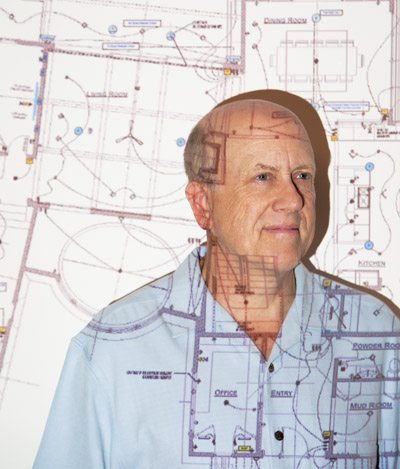Five Questions: Brad Smith
September 21, 2017
Brad Smith, president of Audio Video Design, on the fast-changing world of home technology.
Text by Robert Kiener Photography by John Soares
 1. How has home technology changed from the days when it was mostly security related?
1. How has home technology changed from the days when it was mostly security related?
We’ve come so far! Today’s home technology can integrate everything in a home from lighting to security to heating to music/video and more. The concept “The Internet of Things,” which refers to everything being online or interconnected, is becoming a reality. At some point almost everything in your home you interact with, from a refrigerator to a washing machine to your lighting, will have inexpensive intelligence so you can operate it automatically. Appliances will constantly diagnose themselves to ensure they work properly. With coming advances in artificial intelligence, the sky is the limit; almost anything in the home that you think of can be interconnected.
2. What is a recent example of home technology that has changed the way we live?
Take, for example, lighting control and automatic shade systems. You can program your lights to come on when you wake up at, say, 20 percent, to light your hallways, then 50 percent later, and then dim them as the light from outside gets brighter. In the evening, your outside landscaping lights will come on according to the time of year. You can also program your lights by themes, such as “dining” or “entertainment” so you don’t have to adjust each light separately. Likewise, by automating your window shades, you can protect furniture or carpets from fading without having to manually adjust each and every shade in your home. It is incredibly convenient.
3. What is the most common mistake people make when buying home technology?
Choosing price over quality. The worst thing to do is to have to re-do a system you are not happy with. One home I worked on cost more than $100,000 just to fix and replace the previous work. This was largely because the installer put in a system that no longer was being serviced; even the keyboards were proprietary, and everything went dead. We work with companies that we are confident will be around a long time. It’s okay if your phone becomes obsolete but not the system that runs your home. You should expect to upgrade a home technology system every five years or so, but not have to totally replace it.
4. There have been a lot of developments in systems that can be controlled remotely. Is this now pretty standard?
It’s wrong to think that everything should be wireless and app-based. We can do amazing things with apps on our phones. For example, I can go on my phone and look at cameras all over my vacation home in the Berkshires, unlock the door, turn on music, do anything. But when I am there and my phone is in its charger in the bedroom and I am downstairs and want to turn on my television, I don’t want to have to run upstairs to go get my phone. I want to be able to use a remote control that’s on the coffee table. Or you don’t want guests to have to download an app to operate the television or the lights. Apps are great, but they are not for everything.
5. What major trends are you seeing in home technology?
The trend of more things in the home being interconnected will continue, and technology will come down in price. Dedicated home theaters are popular. One trend we see is that the outdoors is becoming more of a room. We are installing a lot of electronics outside, and not just music. Outdoor WiFi access points are popular. We also install outdoor televisions that are completely weatherproof—waterproof, sun proof, reflection free—and can stay out all year long. These are great for patios, barbecue areas, and spas. Everyone can now watch the big game outside!
Audio Video Design, Westwood, Mass., (617) 965-4600, and Osterville, Mass., (508) 428-1435, avdesigns.com
Share
![NEH-Logo_Black[1] NEH-Logo_Black[1]](https://b2915716.smushcdn.com/2915716/wp-content/uploads/2022/08/NEH-Logo_Black1-300x162.jpg?lossy=1&strip=1&webp=1)









You must be logged in to post a comment.